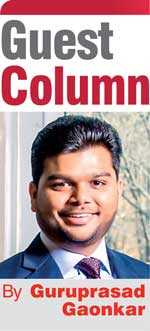Sunday Dec 28, 2025
Sunday Dec 28, 2025
Wednesday, 10 July 2019 00:00 - - {{hitsCtrl.values.hits}}

Nearly 50% of Asia’s population will inhabit urban areas by 2026, putting a massive amount of pressure on its already under-developed infrastructure and supply chains. Undoubtedly, the responsibility of maintaining efficient supply chains not only lies with delivery companies but the entire logistics value chain. 
As one of the most dominant economic power houses globally, Asia Pacific receives approximately 70% of the world’s container traffic in its ports, which increases the difficulty in managing these complex supply chains as compared to other parts of the world. However, by capitalising on strong government support and embracing smarter technologies, logistics businesses can further improve transparency and efficiency across their supply chains and boost local economies.
Digitalise to reduce fragmentation
We’ve seen technology grow and transform many industries and supply chain is no different. Legacy supply chain management systems are linear and siloed which doesn’t allow for fluidity of the ever-changing demand.
Supply chains need to be agile enough to change, as well as digitally connected from end-to-end. However, Asia is very fragmented and businesses here need to grapple with complex challenges – such as economic, geographical and infrastructural disparity, cultural diversity, language differences and country-specific regulations.
Amidst these complexities, digital technology can help solve existing inefficiencies and other underlying issues in the logistics sector. In the past, legacy systems relied on third-party providers to support specific channels. This causes gaps in visibility and challenges in service consistency. Digitalisation is a game changer – by standardising procedures, enhancing end-to-end visibility and empowering all logistics partners to facilitate shipments across all countries in the region seamlessly.
Doing nothing is not an option
Recognising the complexities resulting from local logistics industries, governments are also embracing digitalisation in Asia. They see an opportunity to not only catch up with mature markets, but also integrate business-to-business and business-to-government processes.
For instance, Singapore, a maritime powerhouse and one of the world’s top logistics hubs, is upgrading itself with the upcoming Tuas Mega Port, harnessing technologies like drones, driverless vehicles and machine learning (ML) to almost double the city state’s current cargo handling volume by year 2040. India, on the other hand, is finalising its ambitious draft national logistics policy this year, creating a national logistics e-marketplace as a one-stop platform for exporters and importers, as well as a single knowledge and information sharing mechanism for all parties. With more than 20 government agencies, 40 partnering government agencies and 37 export promotion councils, India’s logistics regulatory landscape is extremely complex. Therefore, having a one-stop portal will significantly improve transparency and cost management, and facilitate better shipping from end to end.
Given strong government support for the logistics industry, the clock is ticking for businesses to catch the next ride to digitalisation or risk losing out on the opportunity to expedite first-to-last-mile logistics.
Moving supply chain to the cloud
By tapping on cloud applications that provide real-time delivery tracking, any organisation inside the supply chain eco-system – from parcel couriers to food delivery platforms – can take (back) control of the data collected to identify any frontline issues, manage inventory and quality, and subsequently inform original suppliers about any issues.
One such business is global shipping and logistics conglomerate Transworld Group, who partnered with Oracle to create an integrated cloud-based technology platform that improved operational efficiency across its shipping and logistics businesses, and ultimately greater customer satisfaction.
Moreover, smart technologies are helping logistics companies be more agile in allocating resources and optimising service levels. Vietnamese logistics company Bac Ky Logistics has implemented Oracle Transportation Management (OTM) and Internet of Things (IOT) Fleet Management Cloud solutions to reduce the number of empty containers and free up its staff to focus on higher value-added services such as automating the scheduling of deliveries and improving its supply chain transparency, speed of service and cost optimisation.
In addition, cloud solutions are pivotal in adopting such emerging technologies like Artificial Intelligence (AI), Machine Learning and robotics that are fuelling tighter, more efficient supply chains. Robotics, for instance, have been a mainstay of manufacturing for decades, but with new improvements in Machine Learning and sensing, robots can analyse massive troves of data and learn from historical performance and trends in order to predict outcomes or propose solutions like a faster route for delivery trucks.
Moreover, AI and Machine Learning can further harness the data collected by the Industrial Internet of Things (IoT) sensors, which remotely locate, manage and control shipping containers and fleets, enabling businesses to instantly access an unprecedented level of real-time information across the modern supply chain.
Dynamic supply chain in a cloud world
There is no doubt that the future of supply chain management is hyper digital. Home to more than eight out of the top 20 global economies by 2050 with its mobile and e-commerce market projected to reach $ 1.6 trillion by 2021, the dynamic Asia Pacific region must move supply chains to the cloud to remain competitive in logistics.
All players across the whole supply chain – from frontline e-retailers to last-mile logistics providers – must capitalise on the cloud to gain easy access to emerging technologies including AI, Machine Learning, IoT and robotics to improve operations efficiencies, automate processes, empower employees, build customer loyalty and even better societies.
[The writer is Oracle's Asia Pacific SaaS Leader, Office of Finance (ERP) & Digital Supply Chain.]